Comprehensive Report: Risk Management Strategies for IT Projects
VerifiedAdded on 2021/06/14
|11
|2661
|42
Report
AI Summary
This report delves into the critical domain of risk management within the realm of Information Technology (IT) projects. It commences by highlighting the substantial failure rates of IT projects, emphasizing the need for effective risk management strategies. The report outlines the key processes of risk management, including context establishment, risk identification, quantification of impact, prioritization, treatment, and monitoring. It identifies common IT project risks across categories such as legal, commercial, economic, human behavior, political, and technical issues. The report underscores the importance of understanding these risks to mitigate their potential negative impacts. Furthermore, it examines various risk treatment techniques, such as avoidance, transfer, reduction, and retention, to ensure project success. Finally, it concludes by stressing the importance of proactively managing risks to improve the likelihood of successful project outcomes.

Running head: RISK MANAGEMENT 1
Risk Management
Name
Institutional Affiliation
Risk Management
Name
Institutional Affiliation
Paraphrase This Document
Need a fresh take? Get an instant paraphrase of this document with our AI Paraphraser
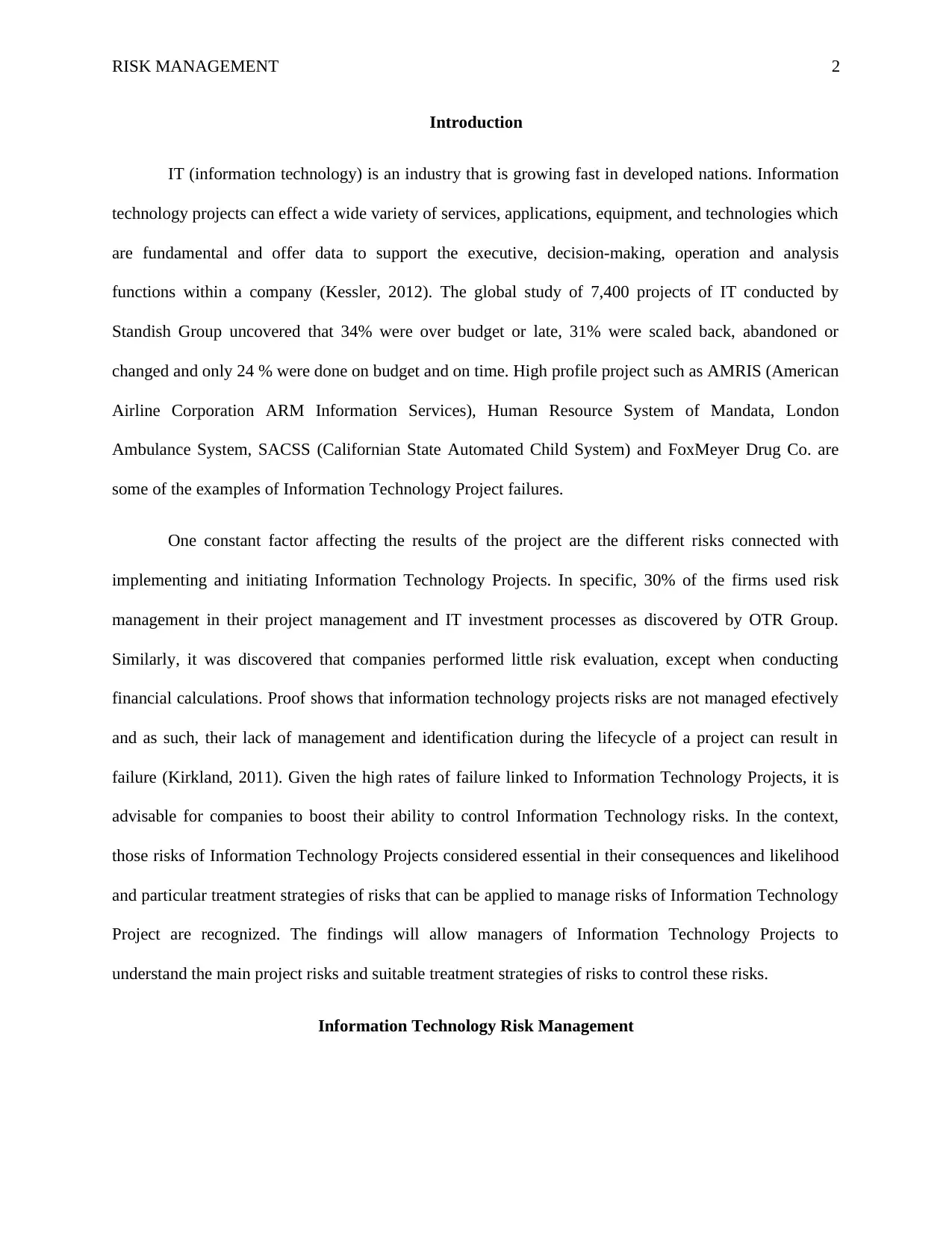
RISK MANAGEMENT 2
Introduction
IT (information technology) is an industry that is growing fast in developed nations. Information
technology projects can effect a wide variety of services, applications, equipment, and technologies which
are fundamental and offer data to support the executive, decision-making, operation and analysis
functions within a company (Kessler, 2012). The global study of 7,400 projects of IT conducted by
Standish Group uncovered that 34% were over budget or late, 31% were scaled back, abandoned or
changed and only 24 % were done on budget and on time. High profile project such as AMRIS (American
Airline Corporation ARM Information Services), Human Resource System of Mandata, London
Ambulance System, SACSS (Californian State Automated Child System) and FoxMeyer Drug Co. are
some of the examples of Information Technology Project failures.
One constant factor affecting the results of the project are the different risks connected with
implementing and initiating Information Technology Projects. In specific, 30% of the firms used risk
management in their project management and IT investment processes as discovered by OTR Group.
Similarly, it was discovered that companies performed little risk evaluation, except when conducting
financial calculations. Proof shows that information technology projects risks are not managed efectively
and as such, their lack of management and identification during the lifecycle of a project can result in
failure (Kirkland, 2011). Given the high rates of failure linked to Information Technology Projects, it is
advisable for companies to boost their ability to control Information Technology risks. In the context,
those risks of Information Technology Projects considered essential in their consequences and likelihood
and particular treatment strategies of risks that can be applied to manage risks of Information Technology
Project are recognized. The findings will allow managers of Information Technology Projects to
understand the main project risks and suitable treatment strategies of risks to control these risks.
Information Technology Risk Management
Introduction
IT (information technology) is an industry that is growing fast in developed nations. Information
technology projects can effect a wide variety of services, applications, equipment, and technologies which
are fundamental and offer data to support the executive, decision-making, operation and analysis
functions within a company (Kessler, 2012). The global study of 7,400 projects of IT conducted by
Standish Group uncovered that 34% were over budget or late, 31% were scaled back, abandoned or
changed and only 24 % were done on budget and on time. High profile project such as AMRIS (American
Airline Corporation ARM Information Services), Human Resource System of Mandata, London
Ambulance System, SACSS (Californian State Automated Child System) and FoxMeyer Drug Co. are
some of the examples of Information Technology Project failures.
One constant factor affecting the results of the project are the different risks connected with
implementing and initiating Information Technology Projects. In specific, 30% of the firms used risk
management in their project management and IT investment processes as discovered by OTR Group.
Similarly, it was discovered that companies performed little risk evaluation, except when conducting
financial calculations. Proof shows that information technology projects risks are not managed efectively
and as such, their lack of management and identification during the lifecycle of a project can result in
failure (Kirkland, 2011). Given the high rates of failure linked to Information Technology Projects, it is
advisable for companies to boost their ability to control Information Technology risks. In the context,
those risks of Information Technology Projects considered essential in their consequences and likelihood
and particular treatment strategies of risks that can be applied to manage risks of Information Technology
Project are recognized. The findings will allow managers of Information Technology Projects to
understand the main project risks and suitable treatment strategies of risks to control these risks.
Information Technology Risk Management
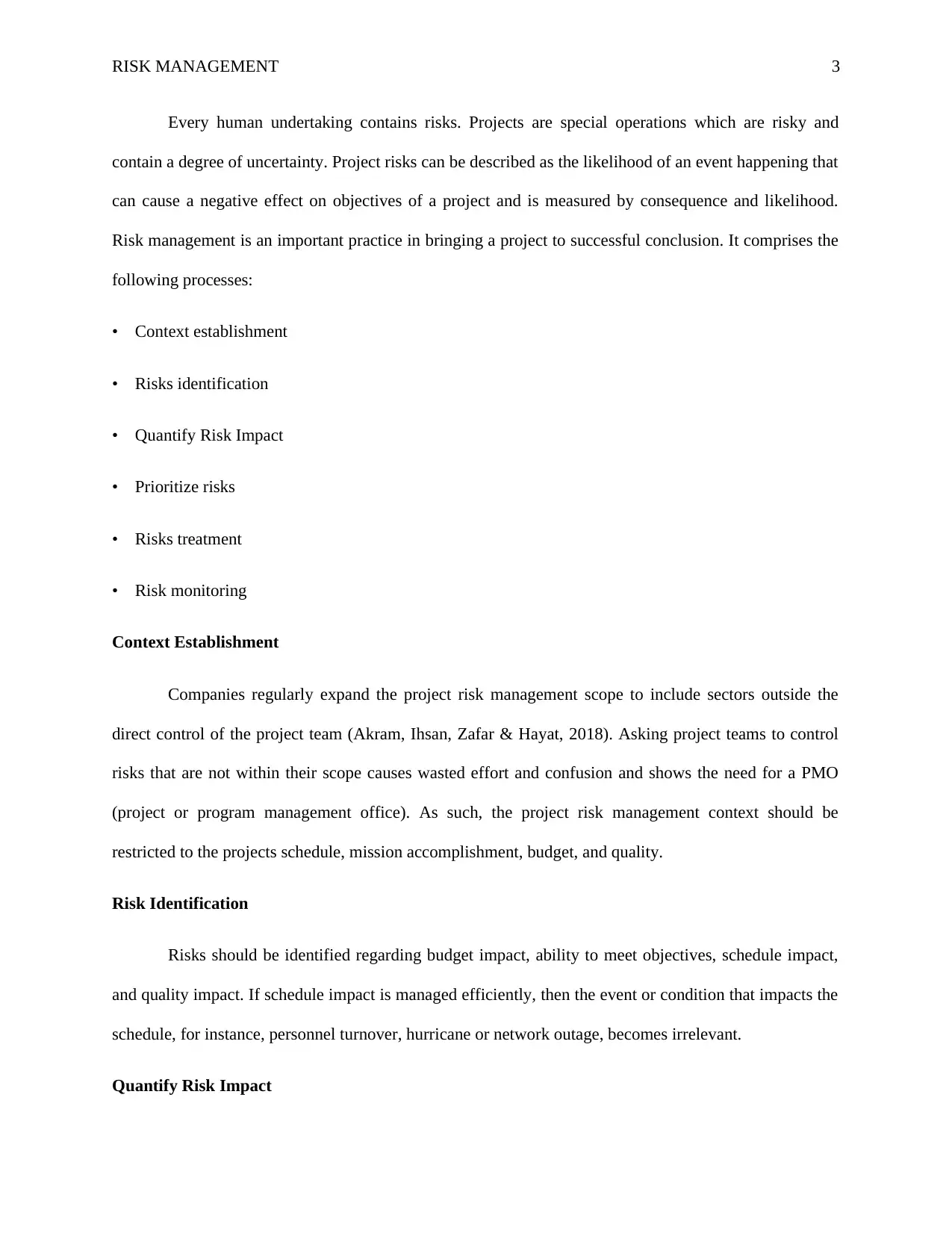
RISK MANAGEMENT 3
Every human undertaking contains risks. Projects are special operations which are risky and
contain a degree of uncertainty. Project risks can be described as the likelihood of an event happening that
can cause a negative effect on objectives of a project and is measured by consequence and likelihood.
Risk management is an important practice in bringing a project to successful conclusion. It comprises the
following processes:
• Context establishment
• Risks identification
• Quantify Risk Impact
• Prioritize risks
• Risks treatment
• Risk monitoring
Context Establishment
Companies regularly expand the project risk management scope to include sectors outside the
direct control of the project team (Akram, Ihsan, Zafar & Hayat, 2018). Asking project teams to control
risks that are not within their scope causes wasted effort and confusion and shows the need for a PMO
(project or program management office). As such, the project risk management context should be
restricted to the projects schedule, mission accomplishment, budget, and quality.
Risk Identification
Risks should be identified regarding budget impact, ability to meet objectives, schedule impact,
and quality impact. If schedule impact is managed efficiently, then the event or condition that impacts the
schedule, for instance, personnel turnover, hurricane or network outage, becomes irrelevant.
Quantify Risk Impact
Every human undertaking contains risks. Projects are special operations which are risky and
contain a degree of uncertainty. Project risks can be described as the likelihood of an event happening that
can cause a negative effect on objectives of a project and is measured by consequence and likelihood.
Risk management is an important practice in bringing a project to successful conclusion. It comprises the
following processes:
• Context establishment
• Risks identification
• Quantify Risk Impact
• Prioritize risks
• Risks treatment
• Risk monitoring
Context Establishment
Companies regularly expand the project risk management scope to include sectors outside the
direct control of the project team (Akram, Ihsan, Zafar & Hayat, 2018). Asking project teams to control
risks that are not within their scope causes wasted effort and confusion and shows the need for a PMO
(project or program management office). As such, the project risk management context should be
restricted to the projects schedule, mission accomplishment, budget, and quality.
Risk Identification
Risks should be identified regarding budget impact, ability to meet objectives, schedule impact,
and quality impact. If schedule impact is managed efficiently, then the event or condition that impacts the
schedule, for instance, personnel turnover, hurricane or network outage, becomes irrelevant.
Quantify Risk Impact
⊘ This is a preview!⊘
Do you want full access?
Subscribe today to unlock all pages.

Trusted by 1+ million students worldwide
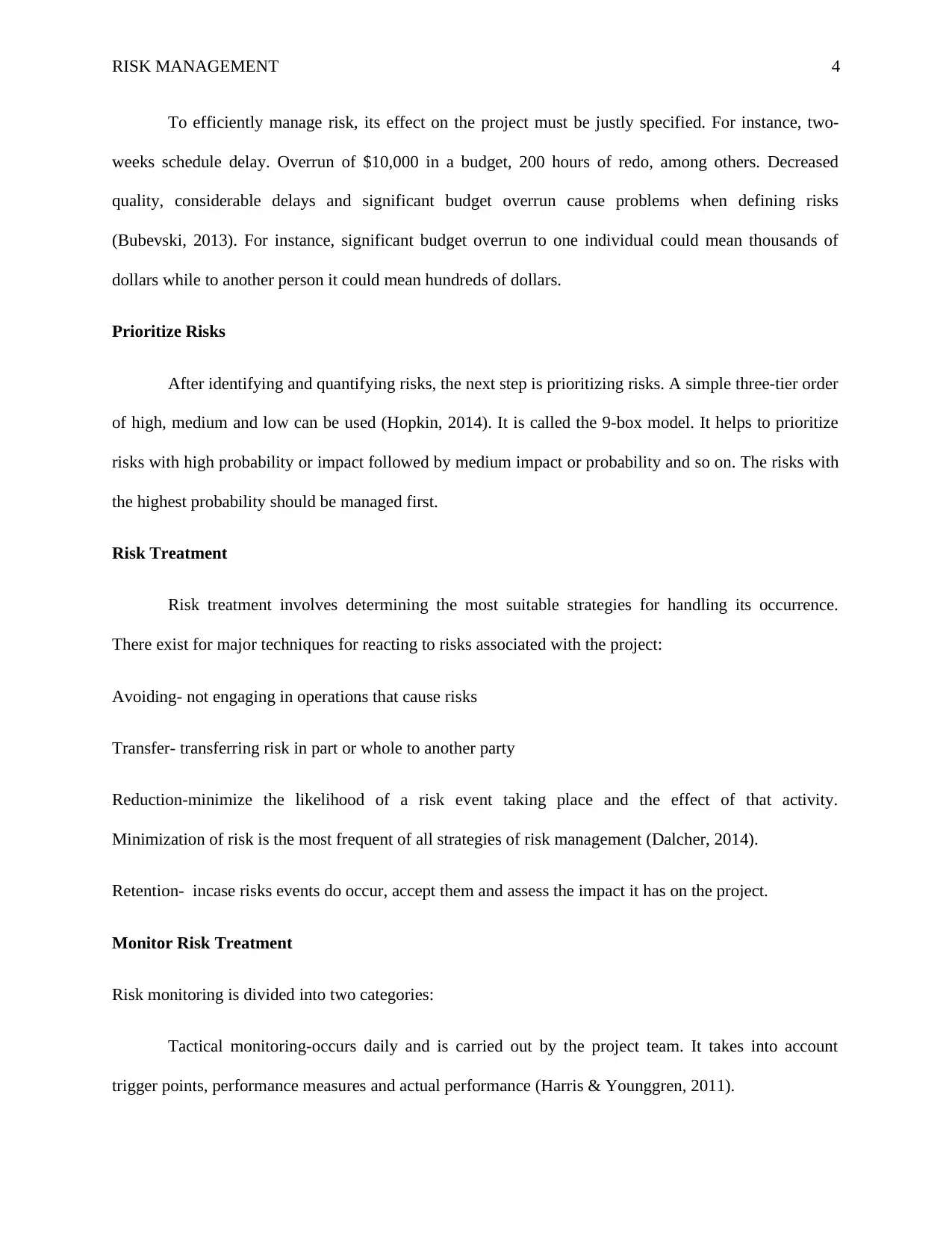
RISK MANAGEMENT 4
To efficiently manage risk, its effect on the project must be justly specified. For instance, two-
weeks schedule delay. Overrun of $10,000 in a budget, 200 hours of redo, among others. Decreased
quality, considerable delays and significant budget overrun cause problems when defining risks
(Bubevski, 2013). For instance, significant budget overrun to one individual could mean thousands of
dollars while to another person it could mean hundreds of dollars.
Prioritize Risks
After identifying and quantifying risks, the next step is prioritizing risks. A simple three-tier order
of high, medium and low can be used (Hopkin, 2014). It is called the 9-box model. It helps to prioritize
risks with high probability or impact followed by medium impact or probability and so on. The risks with
the highest probability should be managed first.
Risk Treatment
Risk treatment involves determining the most suitable strategies for handling its occurrence.
There exist for major techniques for reacting to risks associated with the project:
Avoiding- not engaging in operations that cause risks
Transfer- transferring risk in part or whole to another party
Reduction-minimize the likelihood of a risk event taking place and the effect of that activity.
Minimization of risk is the most frequent of all strategies of risk management (Dalcher, 2014).
Retention- incase risks events do occur, accept them and assess the impact it has on the project.
Monitor Risk Treatment
Risk monitoring is divided into two categories:
Tactical monitoring-occurs daily and is carried out by the project team. It takes into account
trigger points, performance measures and actual performance (Harris & Younggren, 2011).
To efficiently manage risk, its effect on the project must be justly specified. For instance, two-
weeks schedule delay. Overrun of $10,000 in a budget, 200 hours of redo, among others. Decreased
quality, considerable delays and significant budget overrun cause problems when defining risks
(Bubevski, 2013). For instance, significant budget overrun to one individual could mean thousands of
dollars while to another person it could mean hundreds of dollars.
Prioritize Risks
After identifying and quantifying risks, the next step is prioritizing risks. A simple three-tier order
of high, medium and low can be used (Hopkin, 2014). It is called the 9-box model. It helps to prioritize
risks with high probability or impact followed by medium impact or probability and so on. The risks with
the highest probability should be managed first.
Risk Treatment
Risk treatment involves determining the most suitable strategies for handling its occurrence.
There exist for major techniques for reacting to risks associated with the project:
Avoiding- not engaging in operations that cause risks
Transfer- transferring risk in part or whole to another party
Reduction-minimize the likelihood of a risk event taking place and the effect of that activity.
Minimization of risk is the most frequent of all strategies of risk management (Dalcher, 2014).
Retention- incase risks events do occur, accept them and assess the impact it has on the project.
Monitor Risk Treatment
Risk monitoring is divided into two categories:
Tactical monitoring-occurs daily and is carried out by the project team. It takes into account
trigger points, performance measures and actual performance (Harris & Younggren, 2011).
Paraphrase This Document
Need a fresh take? Get an instant paraphrase of this document with our AI Paraphraser
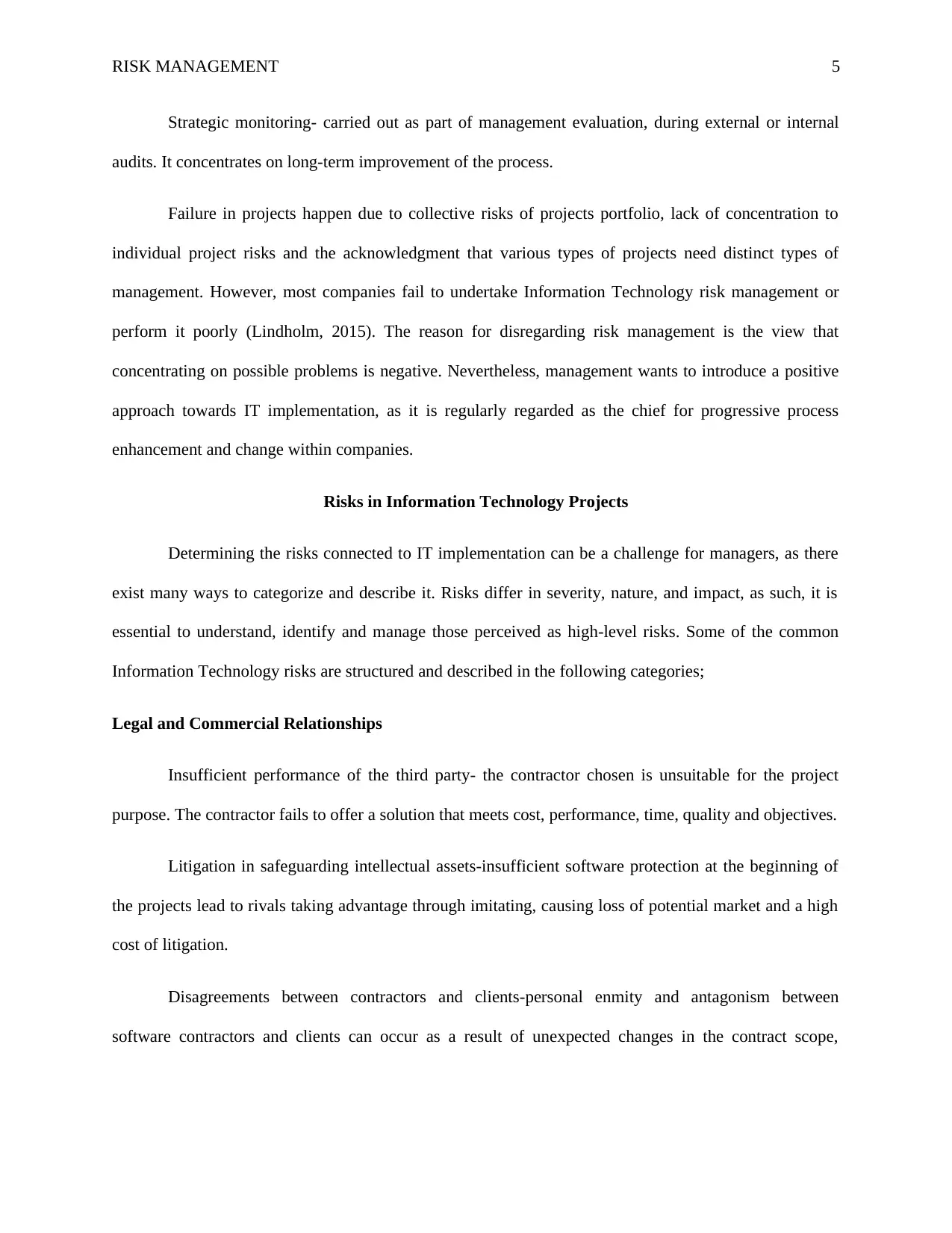
RISK MANAGEMENT 5
Strategic monitoring- carried out as part of management evaluation, during external or internal
audits. It concentrates on long-term improvement of the process.
Failure in projects happen due to collective risks of projects portfolio, lack of concentration to
individual project risks and the acknowledgment that various types of projects need distinct types of
management. However, most companies fail to undertake Information Technology risk management or
perform it poorly (Lindholm, 2015). The reason for disregarding risk management is the view that
concentrating on possible problems is negative. Nevertheless, management wants to introduce a positive
approach towards IT implementation, as it is regularly regarded as the chief for progressive process
enhancement and change within companies.
Risks in Information Technology Projects
Determining the risks connected to IT implementation can be a challenge for managers, as there
exist many ways to categorize and describe it. Risks differ in severity, nature, and impact, as such, it is
essential to understand, identify and manage those perceived as high-level risks. Some of the common
Information Technology risks are structured and described in the following categories;
Legal and Commercial Relationships
Insufficient performance of the third party- the contractor chosen is unsuitable for the project
purpose. The contractor fails to offer a solution that meets cost, performance, time, quality and objectives.
Litigation in safeguarding intellectual assets-insufficient software protection at the beginning of
the projects lead to rivals taking advantage through imitating, causing loss of potential market and a high
cost of litigation.
Disagreements between contractors and clients-personal enmity and antagonism between
software contractors and clients can occur as a result of unexpected changes in the contract scope,
Strategic monitoring- carried out as part of management evaluation, during external or internal
audits. It concentrates on long-term improvement of the process.
Failure in projects happen due to collective risks of projects portfolio, lack of concentration to
individual project risks and the acknowledgment that various types of projects need distinct types of
management. However, most companies fail to undertake Information Technology risk management or
perform it poorly (Lindholm, 2015). The reason for disregarding risk management is the view that
concentrating on possible problems is negative. Nevertheless, management wants to introduce a positive
approach towards IT implementation, as it is regularly regarded as the chief for progressive process
enhancement and change within companies.
Risks in Information Technology Projects
Determining the risks connected to IT implementation can be a challenge for managers, as there
exist many ways to categorize and describe it. Risks differ in severity, nature, and impact, as such, it is
essential to understand, identify and manage those perceived as high-level risks. Some of the common
Information Technology risks are structured and described in the following categories;
Legal and Commercial Relationships
Insufficient performance of the third party- the contractor chosen is unsuitable for the project
purpose. The contractor fails to offer a solution that meets cost, performance, time, quality and objectives.
Litigation in safeguarding intellectual assets-insufficient software protection at the beginning of
the projects lead to rivals taking advantage through imitating, causing loss of potential market and a high
cost of litigation.
Disagreements between contractors and clients-personal enmity and antagonism between
software contractors and clients can occur as a result of unexpected changes in the contract scope,
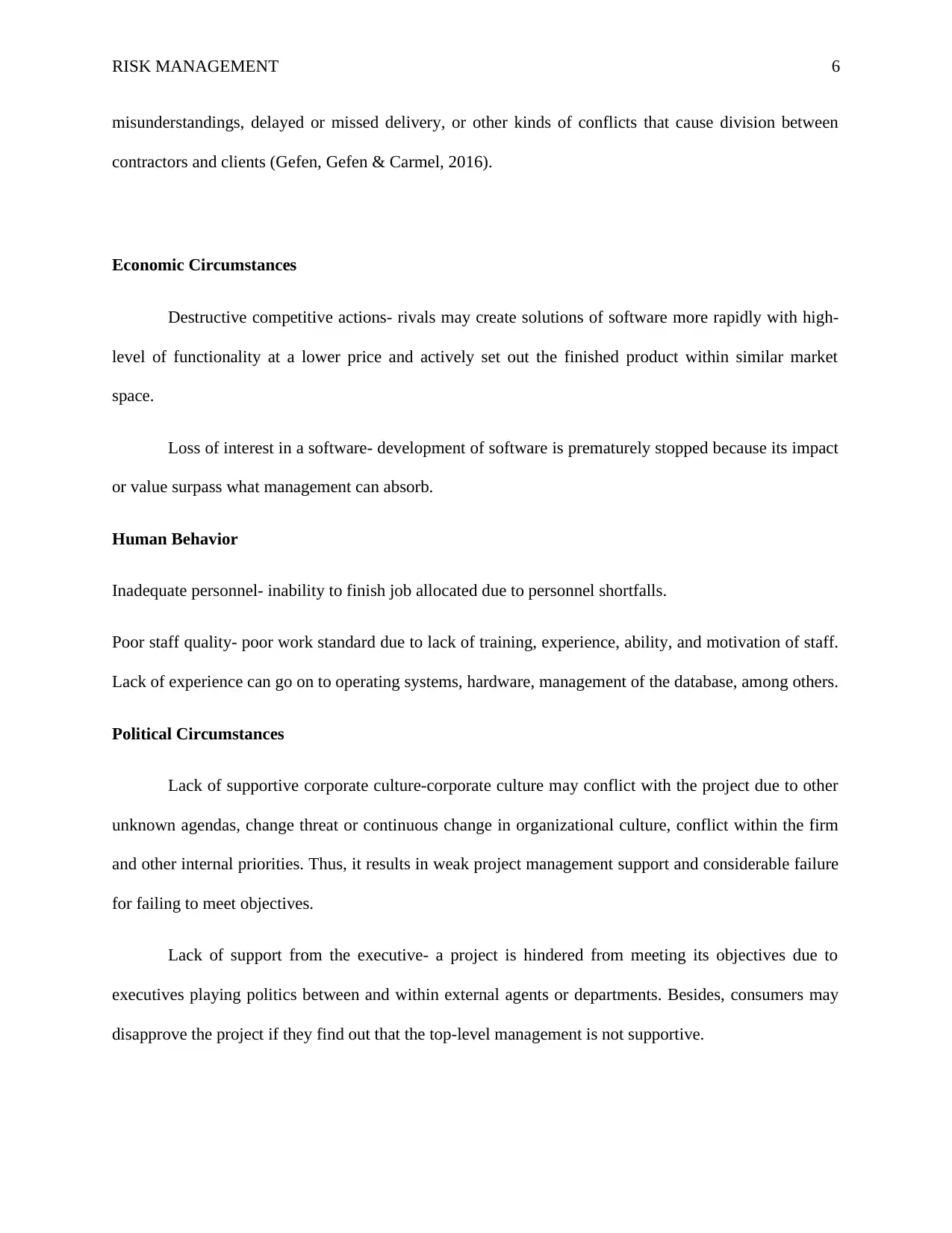
RISK MANAGEMENT 6
misunderstandings, delayed or missed delivery, or other kinds of conflicts that cause division between
contractors and clients (Gefen, Gefen & Carmel, 2016).
Economic Circumstances
Destructive competitive actions- rivals may create solutions of software more rapidly with high-
level of functionality at a lower price and actively set out the finished product within similar market
space.
Loss of interest in a software- development of software is prematurely stopped because its impact
or value surpass what management can absorb.
Human Behavior
Inadequate personnel- inability to finish job allocated due to personnel shortfalls.
Poor staff quality- poor work standard due to lack of training, experience, ability, and motivation of staff.
Lack of experience can go on to operating systems, hardware, management of the database, among others.
Political Circumstances
Lack of supportive corporate culture-corporate culture may conflict with the project due to other
unknown agendas, change threat or continuous change in organizational culture, conflict within the firm
and other internal priorities. Thus, it results in weak project management support and considerable failure
for failing to meet objectives.
Lack of support from the executive- a project is hindered from meeting its objectives due to
executives playing politics between and within external agents or departments. Besides, consumers may
disapprove the project if they find out that the top-level management is not supportive.
misunderstandings, delayed or missed delivery, or other kinds of conflicts that cause division between
contractors and clients (Gefen, Gefen & Carmel, 2016).
Economic Circumstances
Destructive competitive actions- rivals may create solutions of software more rapidly with high-
level of functionality at a lower price and actively set out the finished product within similar market
space.
Loss of interest in a software- development of software is prematurely stopped because its impact
or value surpass what management can absorb.
Human Behavior
Inadequate personnel- inability to finish job allocated due to personnel shortfalls.
Poor staff quality- poor work standard due to lack of training, experience, ability, and motivation of staff.
Lack of experience can go on to operating systems, hardware, management of the database, among others.
Political Circumstances
Lack of supportive corporate culture-corporate culture may conflict with the project due to other
unknown agendas, change threat or continuous change in organizational culture, conflict within the firm
and other internal priorities. Thus, it results in weak project management support and considerable failure
for failing to meet objectives.
Lack of support from the executive- a project is hindered from meeting its objectives due to
executives playing politics between and within external agents or departments. Besides, consumers may
disapprove the project if they find out that the top-level management is not supportive.
⊘ This is a preview!⊘
Do you want full access?
Subscribe today to unlock all pages.

Trusted by 1+ million students worldwide
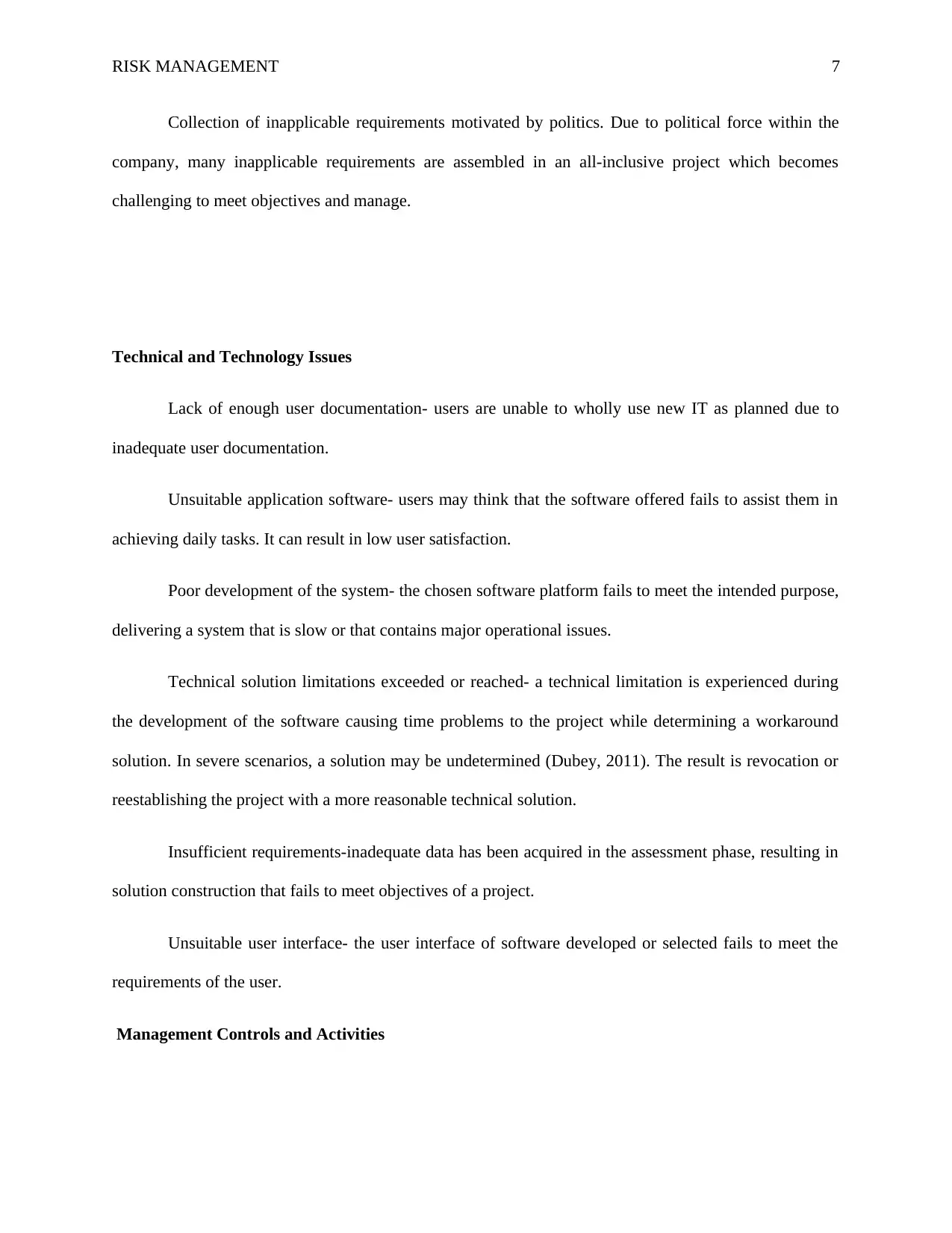
RISK MANAGEMENT 7
Collection of inapplicable requirements motivated by politics. Due to political force within the
company, many inapplicable requirements are assembled in an all-inclusive project which becomes
challenging to meet objectives and manage.
Technical and Technology Issues
Lack of enough user documentation- users are unable to wholly use new IT as planned due to
inadequate user documentation.
Unsuitable application software- users may think that the software offered fails to assist them in
achieving daily tasks. It can result in low user satisfaction.
Poor development of the system- the chosen software platform fails to meet the intended purpose,
delivering a system that is slow or that contains major operational issues.
Technical solution limitations exceeded or reached- a technical limitation is experienced during
the development of the software causing time problems to the project while determining a workaround
solution. In severe scenarios, a solution may be undetermined (Dubey, 2011). The result is revocation or
reestablishing the project with a more reasonable technical solution.
Insufficient requirements-inadequate data has been acquired in the assessment phase, resulting in
solution construction that fails to meet objectives of a project.
Unsuitable user interface- the user interface of software developed or selected fails to meet the
requirements of the user.
Management Controls and Activities
Collection of inapplicable requirements motivated by politics. Due to political force within the
company, many inapplicable requirements are assembled in an all-inclusive project which becomes
challenging to meet objectives and manage.
Technical and Technology Issues
Lack of enough user documentation- users are unable to wholly use new IT as planned due to
inadequate user documentation.
Unsuitable application software- users may think that the software offered fails to assist them in
achieving daily tasks. It can result in low user satisfaction.
Poor development of the system- the chosen software platform fails to meet the intended purpose,
delivering a system that is slow or that contains major operational issues.
Technical solution limitations exceeded or reached- a technical limitation is experienced during
the development of the software causing time problems to the project while determining a workaround
solution. In severe scenarios, a solution may be undetermined (Dubey, 2011). The result is revocation or
reestablishing the project with a more reasonable technical solution.
Insufficient requirements-inadequate data has been acquired in the assessment phase, resulting in
solution construction that fails to meet objectives of a project.
Unsuitable user interface- the user interface of software developed or selected fails to meet the
requirements of the user.
Management Controls and Activities
Paraphrase This Document
Need a fresh take? Get an instant paraphrase of this document with our AI Paraphraser
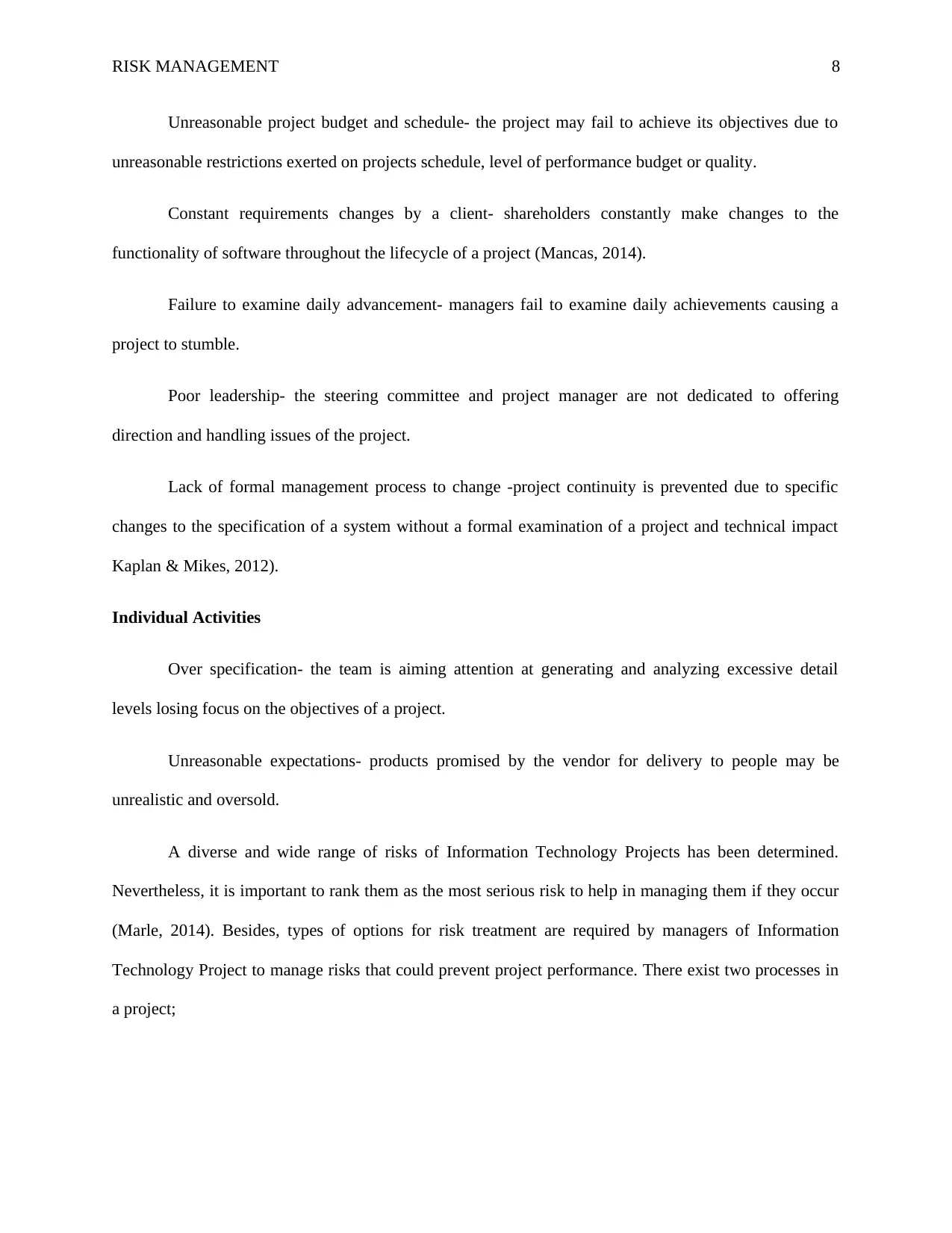
RISK MANAGEMENT 8
Unreasonable project budget and schedule- the project may fail to achieve its objectives due to
unreasonable restrictions exerted on projects schedule, level of performance budget or quality.
Constant requirements changes by a client- shareholders constantly make changes to the
functionality of software throughout the lifecycle of a project (Mancas, 2014).
Failure to examine daily advancement- managers fail to examine daily achievements causing a
project to stumble.
Poor leadership- the steering committee and project manager are not dedicated to offering
direction and handling issues of the project.
Lack of formal management process to change -project continuity is prevented due to specific
changes to the specification of a system without a formal examination of a project and technical impact
Kaplan & Mikes, 2012).
Individual Activities
Over specification- the team is aiming attention at generating and analyzing excessive detail
levels losing focus on the objectives of a project.
Unreasonable expectations- products promised by the vendor for delivery to people may be
unrealistic and oversold.
A diverse and wide range of risks of Information Technology Projects has been determined.
Nevertheless, it is important to rank them as the most serious risk to help in managing them if they occur
(Marle, 2014). Besides, types of options for risk treatment are required by managers of Information
Technology Project to manage risks that could prevent project performance. There exist two processes in
a project;
Unreasonable project budget and schedule- the project may fail to achieve its objectives due to
unreasonable restrictions exerted on projects schedule, level of performance budget or quality.
Constant requirements changes by a client- shareholders constantly make changes to the
functionality of software throughout the lifecycle of a project (Mancas, 2014).
Failure to examine daily advancement- managers fail to examine daily achievements causing a
project to stumble.
Poor leadership- the steering committee and project manager are not dedicated to offering
direction and handling issues of the project.
Lack of formal management process to change -project continuity is prevented due to specific
changes to the specification of a system without a formal examination of a project and technical impact
Kaplan & Mikes, 2012).
Individual Activities
Over specification- the team is aiming attention at generating and analyzing excessive detail
levels losing focus on the objectives of a project.
Unreasonable expectations- products promised by the vendor for delivery to people may be
unrealistic and oversold.
A diverse and wide range of risks of Information Technology Projects has been determined.
Nevertheless, it is important to rank them as the most serious risk to help in managing them if they occur
(Marle, 2014). Besides, types of options for risk treatment are required by managers of Information
Technology Project to manage risks that could prevent project performance. There exist two processes in
a project;
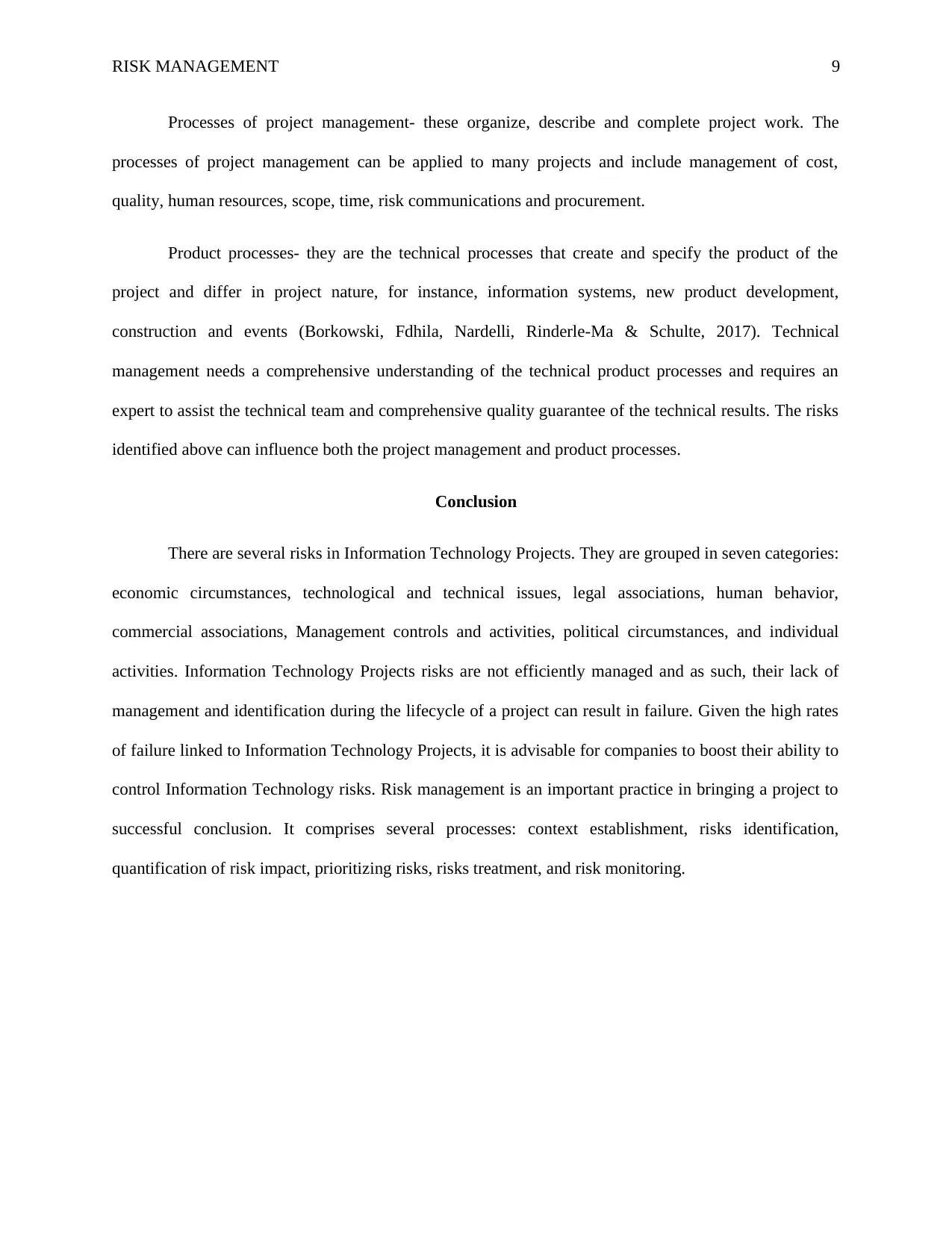
RISK MANAGEMENT 9
Processes of project management- these organize, describe and complete project work. The
processes of project management can be applied to many projects and include management of cost,
quality, human resources, scope, time, risk communications and procurement.
Product processes- they are the technical processes that create and specify the product of the
project and differ in project nature, for instance, information systems, new product development,
construction and events (Borkowski, Fdhila, Nardelli, Rinderle-Ma & Schulte, 2017). Technical
management needs a comprehensive understanding of the technical product processes and requires an
expert to assist the technical team and comprehensive quality guarantee of the technical results. The risks
identified above can influence both the project management and product processes.
Conclusion
There are several risks in Information Technology Projects. They are grouped in seven categories:
economic circumstances, technological and technical issues, legal associations, human behavior,
commercial associations, Management controls and activities, political circumstances, and individual
activities. Information Technology Projects risks are not efficiently managed and as such, their lack of
management and identification during the lifecycle of a project can result in failure. Given the high rates
of failure linked to Information Technology Projects, it is advisable for companies to boost their ability to
control Information Technology risks. Risk management is an important practice in bringing a project to
successful conclusion. It comprises several processes: context establishment, risks identification,
quantification of risk impact, prioritizing risks, risks treatment, and risk monitoring.
Processes of project management- these organize, describe and complete project work. The
processes of project management can be applied to many projects and include management of cost,
quality, human resources, scope, time, risk communications and procurement.
Product processes- they are the technical processes that create and specify the product of the
project and differ in project nature, for instance, information systems, new product development,
construction and events (Borkowski, Fdhila, Nardelli, Rinderle-Ma & Schulte, 2017). Technical
management needs a comprehensive understanding of the technical product processes and requires an
expert to assist the technical team and comprehensive quality guarantee of the technical results. The risks
identified above can influence both the project management and product processes.
Conclusion
There are several risks in Information Technology Projects. They are grouped in seven categories:
economic circumstances, technological and technical issues, legal associations, human behavior,
commercial associations, Management controls and activities, political circumstances, and individual
activities. Information Technology Projects risks are not efficiently managed and as such, their lack of
management and identification during the lifecycle of a project can result in failure. Given the high rates
of failure linked to Information Technology Projects, it is advisable for companies to boost their ability to
control Information Technology risks. Risk management is an important practice in bringing a project to
successful conclusion. It comprises several processes: context establishment, risks identification,
quantification of risk impact, prioritizing risks, risks treatment, and risk monitoring.
⊘ This is a preview!⊘
Do you want full access?
Subscribe today to unlock all pages.

Trusted by 1+ million students worldwide
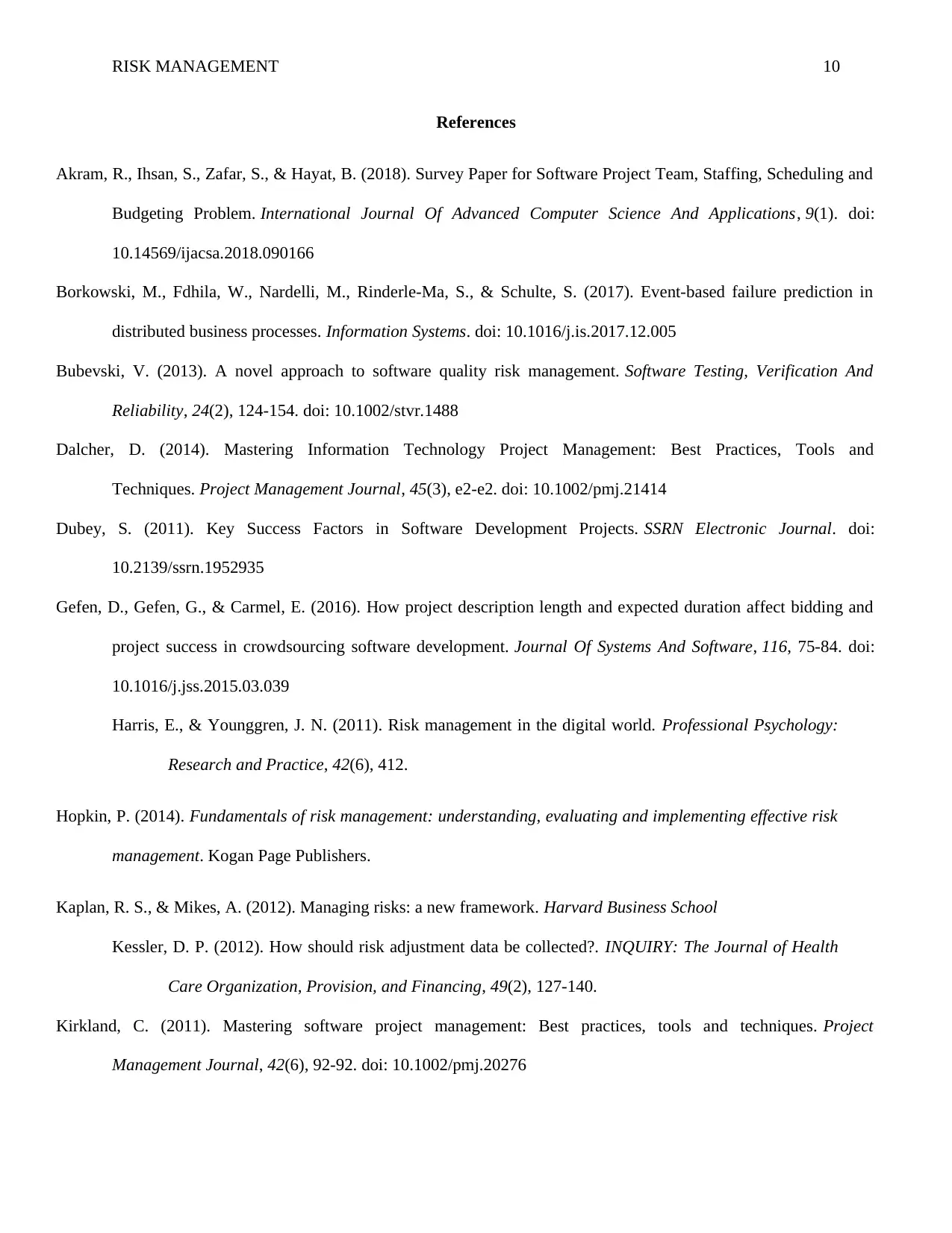
RISK MANAGEMENT 10
References
Akram, R., Ihsan, S., Zafar, S., & Hayat, B. (2018). Survey Paper for Software Project Team, Staffing, Scheduling and
Budgeting Problem. International Journal Of Advanced Computer Science And Applications, 9(1). doi:
10.14569/ijacsa.2018.090166
Borkowski, M., Fdhila, W., Nardelli, M., Rinderle-Ma, S., & Schulte, S. (2017). Event-based failure prediction in
distributed business processes. Information Systems. doi: 10.1016/j.is.2017.12.005
Bubevski, V. (2013). A novel approach to software quality risk management. Software Testing, Verification And
Reliability, 24(2), 124-154. doi: 10.1002/stvr.1488
Dalcher, D. (2014). Mastering Information Technology Project Management: Best Practices, Tools and
Techniques. Project Management Journal, 45(3), e2-e2. doi: 10.1002/pmj.21414
Dubey, S. (2011). Key Success Factors in Software Development Projects. SSRN Electronic Journal. doi:
10.2139/ssrn.1952935
Gefen, D., Gefen, G., & Carmel, E. (2016). How project description length and expected duration affect bidding and
project success in crowdsourcing software development. Journal Of Systems And Software, 116, 75-84. doi:
10.1016/j.jss.2015.03.039
Harris, E., & Younggren, J. N. (2011). Risk management in the digital world. Professional Psychology:
Research and Practice, 42(6), 412.
Hopkin, P. (2014). Fundamentals of risk management: understanding, evaluating and implementing effective risk
management. Kogan Page Publishers.
Kaplan, R. S., & Mikes, A. (2012). Managing risks: a new framework. Harvard Business School
Kessler, D. P. (2012). How should risk adjustment data be collected?. INQUIRY: The Journal of Health
Care Organization, Provision, and Financing, 49(2), 127-140.
Kirkland, C. (2011). Mastering software project management: Best practices, tools and techniques. Project
Management Journal, 42(6), 92-92. doi: 10.1002/pmj.20276
References
Akram, R., Ihsan, S., Zafar, S., & Hayat, B. (2018). Survey Paper for Software Project Team, Staffing, Scheduling and
Budgeting Problem. International Journal Of Advanced Computer Science And Applications, 9(1). doi:
10.14569/ijacsa.2018.090166
Borkowski, M., Fdhila, W., Nardelli, M., Rinderle-Ma, S., & Schulte, S. (2017). Event-based failure prediction in
distributed business processes. Information Systems. doi: 10.1016/j.is.2017.12.005
Bubevski, V. (2013). A novel approach to software quality risk management. Software Testing, Verification And
Reliability, 24(2), 124-154. doi: 10.1002/stvr.1488
Dalcher, D. (2014). Mastering Information Technology Project Management: Best Practices, Tools and
Techniques. Project Management Journal, 45(3), e2-e2. doi: 10.1002/pmj.21414
Dubey, S. (2011). Key Success Factors in Software Development Projects. SSRN Electronic Journal. doi:
10.2139/ssrn.1952935
Gefen, D., Gefen, G., & Carmel, E. (2016). How project description length and expected duration affect bidding and
project success in crowdsourcing software development. Journal Of Systems And Software, 116, 75-84. doi:
10.1016/j.jss.2015.03.039
Harris, E., & Younggren, J. N. (2011). Risk management in the digital world. Professional Psychology:
Research and Practice, 42(6), 412.
Hopkin, P. (2014). Fundamentals of risk management: understanding, evaluating and implementing effective risk
management. Kogan Page Publishers.
Kaplan, R. S., & Mikes, A. (2012). Managing risks: a new framework. Harvard Business School
Kessler, D. P. (2012). How should risk adjustment data be collected?. INQUIRY: The Journal of Health
Care Organization, Provision, and Financing, 49(2), 127-140.
Kirkland, C. (2011). Mastering software project management: Best practices, tools and techniques. Project
Management Journal, 42(6), 92-92. doi: 10.1002/pmj.20276
Paraphrase This Document
Need a fresh take? Get an instant paraphrase of this document with our AI Paraphraser
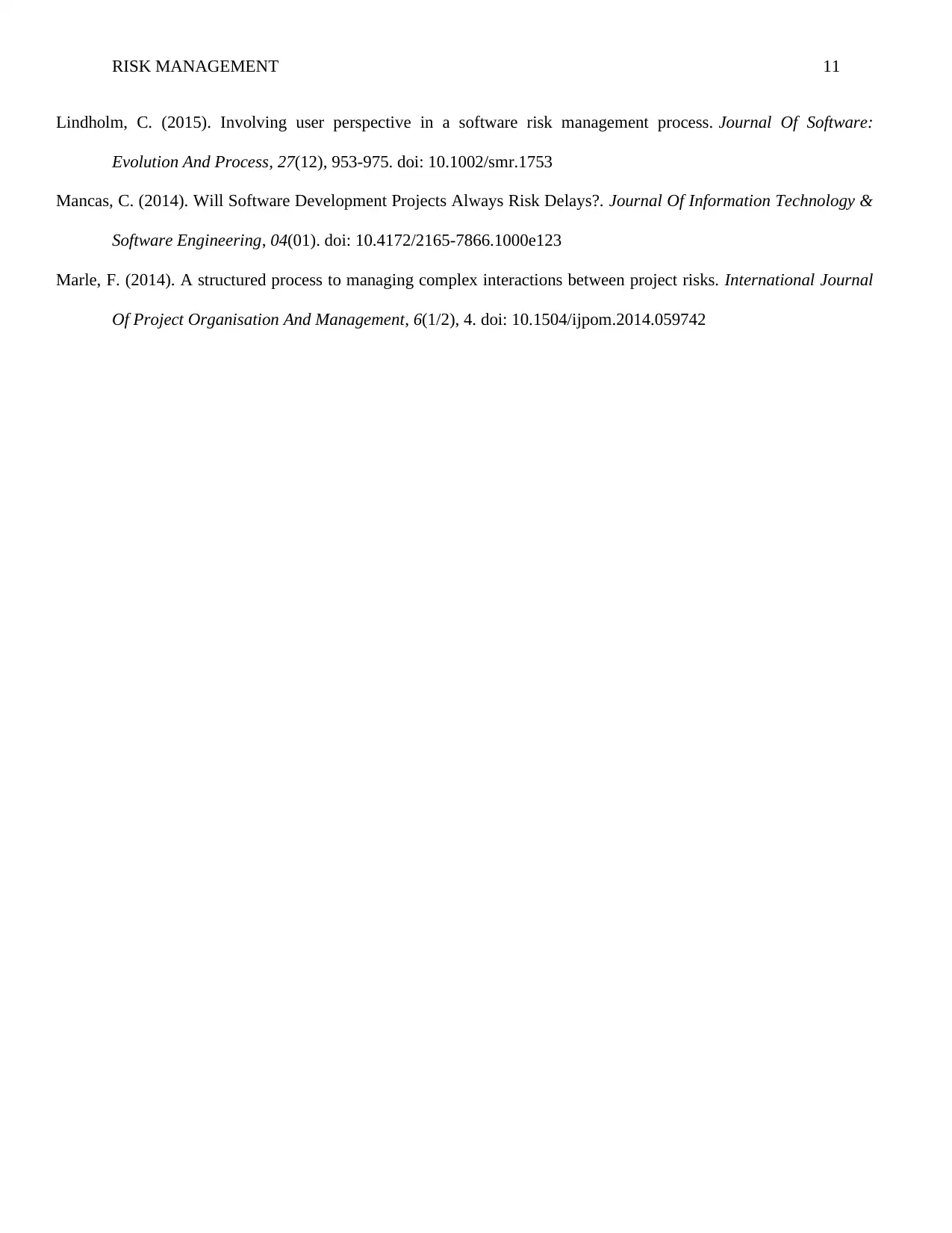
RISK MANAGEMENT 11
Lindholm, C. (2015). Involving user perspective in a software risk management process. Journal Of Software:
Evolution And Process, 27(12), 953-975. doi: 10.1002/smr.1753
Mancas, C. (2014). Will Software Development Projects Always Risk Delays?. Journal Of Information Technology &
Software Engineering, 04(01). doi: 10.4172/2165-7866.1000e123
Marle, F. (2014). A structured process to managing complex interactions between project risks. International Journal
Of Project Organisation And Management, 6(1/2), 4. doi: 10.1504/ijpom.2014.059742
Lindholm, C. (2015). Involving user perspective in a software risk management process. Journal Of Software:
Evolution And Process, 27(12), 953-975. doi: 10.1002/smr.1753
Mancas, C. (2014). Will Software Development Projects Always Risk Delays?. Journal Of Information Technology &
Software Engineering, 04(01). doi: 10.4172/2165-7866.1000e123
Marle, F. (2014). A structured process to managing complex interactions between project risks. International Journal
Of Project Organisation And Management, 6(1/2), 4. doi: 10.1504/ijpom.2014.059742
1 out of 11
Related Documents
Your All-in-One AI-Powered Toolkit for Academic Success.
+13062052269
info@desklib.com
Available 24*7 on WhatsApp / Email
![[object Object]](/_next/static/media/star-bottom.7253800d.svg)
Unlock your academic potential
Copyright © 2020–2025 A2Z Services. All Rights Reserved. Developed and managed by ZUCOL.





